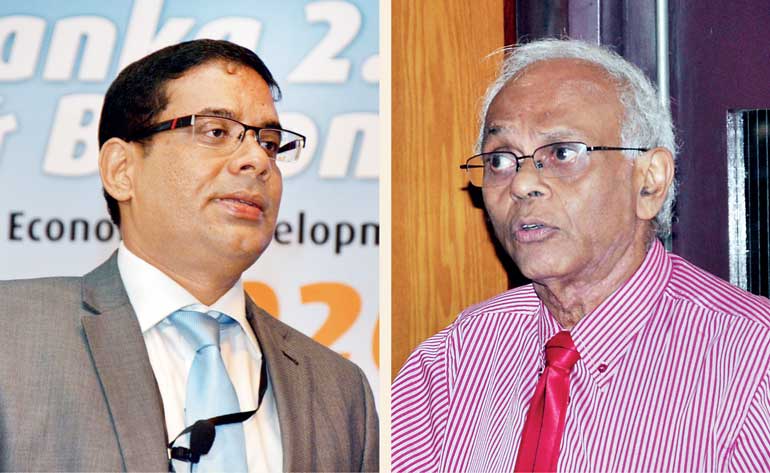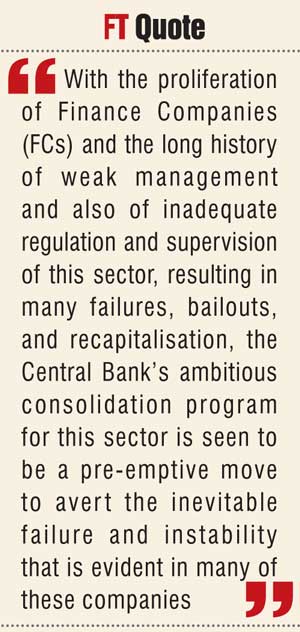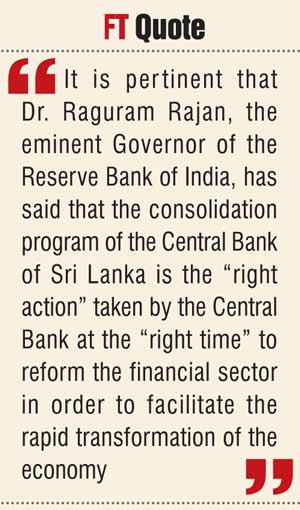Saturday Apr 20, 2024
Saturday Apr 20, 2024
Thursday, 21 May 2015 00:05 - - {{hitsCtrl.values.hits}}
 The Central Bank’s Financial Sector Consolidation Plan (FSCP) is being revisited and a Committee appointed by the Prime Minister and headed by Dinesh Weerakkody (left), in which the former senior Deputy Governor of the Central Bank, W.A. Wijewardena (right) also participated, was tasked with examining the FSCP and making their recommendations. Their report has already been handed over to the Prime Minister but has still not been made public
The Central Bank’s Financial Sector Consolidation Plan (FSCP) is being revisited and a Committee appointed by the Prime Minister and headed by Dinesh Weerakkody (left), in which the former senior Deputy Governor of the Central Bank, W.A. Wijewardena (right) also participated, was tasked with examining the FSCP and making their recommendations. Their report has already been handed over to the Prime Minister but has still not been made public
The Central Bank’s financial sector consolidation plan which was presented in the Budget of the previous Government in 2014, it is widely acclaimed, was a very strong statement of intent.
It was the Central Bank’s response to the post-war macroeconomic environment and the growth momentum of the post war economy in Sri Lanka, which is one of the many ways in which the financial consolidation process takes shape in mature markets, and where the process is market driven.
In emerging markets, however, especially in the South East Asian region, financial consolidation is seen to be a proactive move by the authorities to deal with crises in particular sectors of the financial system and is therefore by fiat of the State or the Central Bank, to be able to achieve the desired objective. 
Consolidation is also a way of tackling excess capacity in the financial system and in the banking system, banking density measured by the population per bank branch, is popularly used to assess an overbanked or underbanked position.
According to the IMF’s financial access survey and the world development indicators as at 2013, at 17 branches per 100,000 population, Sri Lanka is comparatively much higher than its peers in India (12.2), Pakistan(9.3), Bangladesh (8.2), Malaysia (11.3), Singapore (10.2), Thailand (12.2), Indonesia (10.4) and the Philippines (8.6), which may lead to the conclusion that we are, indeed, overbanked. Which then provokes the question – Is the financial system fragmented? Let us first look at the make-up of the financial system to be able to understand this concern better.
Our banking sector constitutes 34 banks, of which 22 are domestic banks (commercial and specialised) and 12 are foreign banks. The assets of the banking sector amount to approximately Rs. 6.7 trillion (end 2014) with only five banks, each maintaining an asset base of over Rs. 500 billion, accounting for a share of 66%. Meanwhile six medium sized banks, including two foreign banks, hold assets between Rs. 100 and 500 billion, accounting for a share of 23%. The balance 23 banks, individually, hold assets less than Rs. 100 billion and account for only 11%.
The three State banks, BOC and PB together with NSB, dominate the banking system, with a market share of 50% of banking system assets. Two private indigenous banks have 20.5% and three have 14%, and together with one foreign bank, all of which with over Rs. 250 billion in assets, represent the Systematically Important Banks (SIBs) in the system.
The non-banking sector or the Non-Bank Financial Institutions (NBFIs), it is evident, is highly-fragmented and constitutes 58 NBFIs, of which 48 are Licensed Finance Companies while the balance 10 are Specialised Leasing Companies. The total assets of the NBFI sector amount to Rs. 750 billion.
Similar to the structure of the banking sector, 13 large NBFIs, each holding assets over Rs. 20 billion, account for 74% of the NBFI’s market share. Meanwhile 13% of the market share is accounted for by eight NBFIs holding assets between Rs. 8 and 20 billion. The remaining 37 small companies, each holding assets of less than Rs. 8 billion, account for only 13% of the NBFI sector (courtesy of the Central Bank’s 64th anniversary oration).
With the proliferation of Finance Companies (FCs) and the long history of weak management and also of inadequate regulation and supervision of this sector, resulting in many failures, bailouts, and recapitalisation, the Central Bank’s ambitious consolidation program for this sector is seen to be a pre-emptive move to avert the inevitable failure and instability that is evident in many of these companies.
Accordingly, it proposed to reduce the NBFIs to 20 from 58, with regulatory support and tax incentives; 10 such mergers have successfully been completed and 22 were in the process. The blueprint for the consolidation of this sector, where strong banks and FCs have been identified to take over the weak FCs, is a well-considered plan, provided the post consolidation supervision of these institutions is strengthened to ensure that the depositors of these licensed institutions that have been merged or taken over, are protected and their interests are safeguarded. This is an obligation and moral responsibility of the Central Bank, arising out of the trust reposed by the public in financial institutions which have been licensed by the central bank and is in the larger interests of the stability of the sector and, indeed, of the financial system.
Looking at the nine specialised banking institutions, the very marginal contribution of seven institutions on the periphery like the regional development banks, etc., are irrelevant in the context of the DFCC and the NSB which together represent 87% of sector assets.
It is therefore interesting to examine the rationale for the consolidation of the only two development finance institutions (DFIs) in the industry i.e. the DFCC and the NDB, the latter which has since transformed itself into a commercial bank, albeit maintaining its mandate for long term development and project finance.
Although much progress had already been made in this regard, over many months, with the change in Government and the consequent change of management at the Central Bank, the Central Bank’s Financial Sector Consolidation Plan (FSCP) is being revisited and a Committee appointed by the Prime Minister and headed by Dinesh Weerakkody, in which the former senior Deputy Governor of the Central Bank, W.A. Wijewardena, also participated, was tasked with examining the FSCP and making their recommendations.
Their report has already been handed over to the Prime Minister but has still not been made public. However, it has just been announced that the MOU entered into between the two institutions has been terminated, giving the banks the freedom to pursue their respective growth strategies until the government’s stance on the FSCP is known.
Historical
The two DFIs, namely the DFCC and the NDB, are two of the strongest and well-managed financial institutions in Sri Lanka, with a long history and a proven track record of long-term development and project financing. The DFCC was established in 1955 with the primary remit of supporting the development needs of the economy. It is proudly acclaimed that it is the ultimate repository of project financing expertise in the country.
The NDB which was established as a State-owned development bank in 1979, transformed itself subsequently in 2005, into a development-oriented commercial bank with the merger of the business of NDB Bank, which it set up to acquire the business of ABN-AMRO Bank in Sri Lanka in 2001. The NDB too, it is acclaimed, has a rich legacy of being one of the premier development financiers in the country for over three decades.
Both institutions on a stand-alone basis project very strong financial soundness indicators (FSIs), which are illustrated in capital strength with Capital Adequacy Ratios well above the regulatory minimum, high asset quality with Non performing ratios and cost management ratios well ahead of the respective industry ratios; and healthy profitability indicators of ROA and ROE. Looking at their growth trajectory over the past 10 years, both institutions project a significant growth trend in assets, deposits and credit. Both institutions are able to raise capital in the domestic market with ease, based on their strong financial performance which guarantees shareholder value by virtue of which they are amongst the most sought-after financial stocks in the market.
Rationale for consolidation
The post-war macroeconomic, surge in the economy, where highly capital-intensive infrastructure projects need to be financed, has caused the authorities to strengthen the country’s financial system and to ensure that the domestic banks which predominate, are poised to meet the demands of a resurgent economy. Indeed, the banks, themselves, should be geared to build up synergies through consolidation, to meet the demand for competitive financing of these projects.
Today, these mega projects bypass the country’s banking system, which is not geared to compete with international banks, which have easy access to low cost foreign funds. It is imperative therefore that these institutions too, if they are to compete on a regional and global level, are able to access foreign funding at competitive rates. This will naturally depend on the strength of the institution which, individually, on their own, by dint of their balance sheet size, pale in comparison to their foreign peers. This severely limits their ability to raise foreign funds at competitive rates. 
The two DFIs have invariably had to go to international financial institutions like the ADB and the IFC, who on-lend funds they mobilise themselves, at a margin above the market rate for long term funds. These funds are thus more costly than if the DFIs were able to access long-term foreign funding directly in the international market.
Historically, these institutions had access to lines of credit to the government of Sri Lanka, which were channelled through them and which were a source of long-term funding for their project lending activities. However, these lines of credit have long since not been forthcoming, and they have had to access foreign funding directly from the international market. Access to foreign funding sources is therefore critical to the developmental role of the DFIs, especially for the financing of SMEs who need to have access to credit at affordable rates, as also for the DFIs to be able to compete with their foreign peers in bidding for large government infrastructure projects.
Synergic benefits
The inevitable synergies accruing from the consolidation of two very strong institutions will sooner, rather than later, enable them to go for an international rating which is integral to their ability to be competitive in the international bond market. The other banks too would benefit greatly from the synergies they will achieve through consolidation., to make them competitive in the regional as well as the global markets, and are undoubted, if such consolidation takes place voluntarily. If it is by fiat of the state or of the central bank, the economies of scale that would be a natural spinoff from this process, would diminish from the restrictions the authorities will inevitably place on staff related matters in particular. The Central Bank’s FSCP has already articulated the terms of consolidation very clearly in this regard.
These are therefore difficult decisions and problems to resolve where the consolidation process is not market driven, as it is in the mature markets of even Singapore and Hong Kong, even though the desired objective of the authorities cannot be achieved. They would rather facilitate the process through tax incentives, and a legislative framework which would encourage consolidation. In emerging economies, however, consolidation has been a response to financial crises, particularly after the Asian financial crisis, a good example of which is Malaysia, where the Central Bank successfully consolidated its financial system into a few strong large banks and, in the process, skilfully eliminated finance companies on a stand-alone basis, by merging them with the banks.
In the case of Singapore, however, the favourable macroeconomic environment combined with appropriate policy responses both from the government, as well as by the Monetary Authority, resulted in the success of its financial consolidation program, with the emergence of 3 strong and very large banks which are able to compete on a regional and international level and, above all, are geared to meet the financial integration objectives of ASEAN.
Market power
While the proposed consolidation of the NBFIs, would create a market oligopoly, the proposed consolidation of the DFIs would hinder competition by creating a monopoly in development finance and the inevitable concentration of market power in one mega institution. However, if the expected economies of scale can be achieved, combined with ready access to cheaper, long-term foreign funding, leading to more competitive pricing of development and project financing, this would be in the larger interests of the consumer and would be welcome.
Conclusion
It is important that due recognition and attention is given to the post consolidation regulation and supervision of such a gigantic institution. Are the regulators ready not only with appropriate regulations to deal with SIBs, but more importantly, to carry out effective, consolidated supervision of these entities?
The recent global financial crisis has brought to the fore, the regulatory burdens of Systematically Important Financial Institutions (SIFIs) and Too Big To Fail (TBTF) institutions. It is imperative that they do not become too big to manage and that there are adequate safeguards to identify, measure and manage the consolidated risks of these entities and that they continue to serve the development needs of all sectors of the economy, particularly of the SMEs, who run the risk of being marginalised in the process. The regulatory and supervisory framework is a key imperative and is integral to the success of any FSCP.
The findings and the recommendations of the Dinesh Weerakkody report would therefore, anxiously be awaited to gauge the Government’s stance on the FSCP. It is important that the considerable work and progress achieved so far, with the involvement of all stakeholders be reckoned, to see the fruition of the FSCP in the larger interests of strengthening Sri Lanka’s financial system and consolidating its position in the regional and international markets.
It is pertinent that Dr. Raguram Rajan, the eminent Governor of the Reserve Bank of India, has said that the consolidation program of the Central Bank of Sri Lanka is the “right action” taken by the Central Bank at the “right time” to reform the financial sector in order to facilitate the rapid transformation of the economy (by courtesy of the Central Bank’s 64th anniversary oration).
[The writer, a former Director of Bank Supervision of the Central Bank, is a Fellow of the Chartered Institute of Bankers of UK (FCIB) and she can be reached at [email protected].]